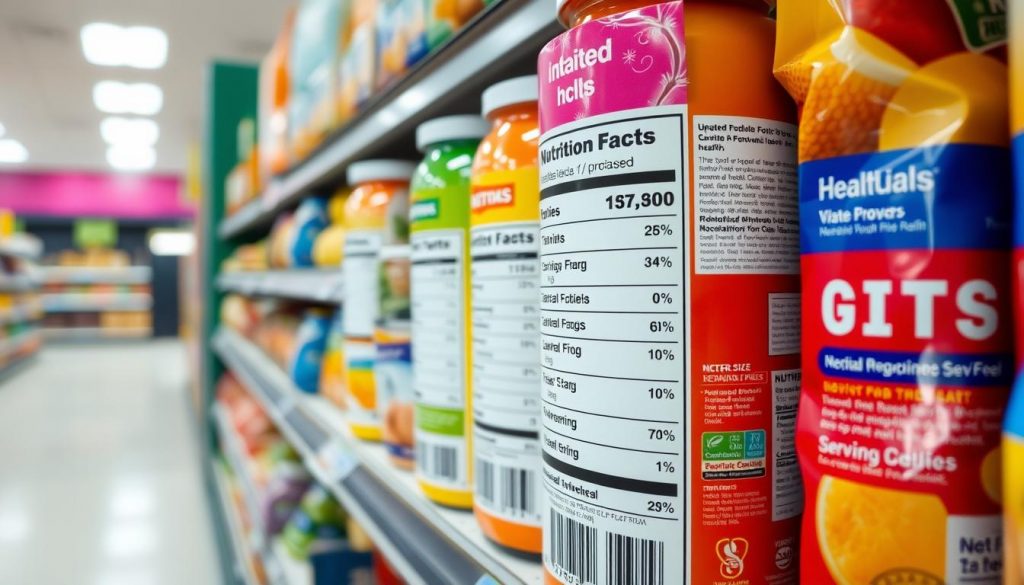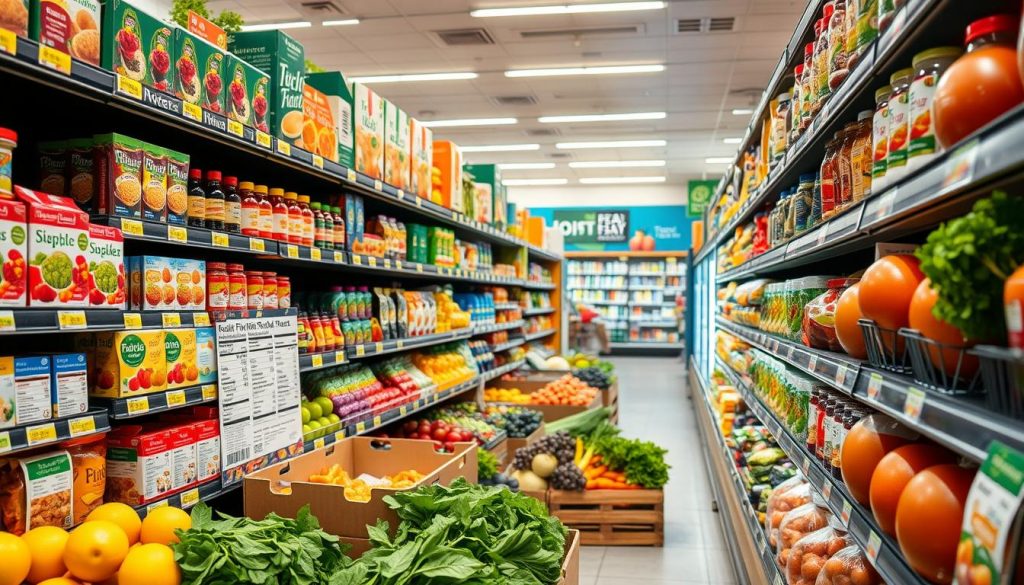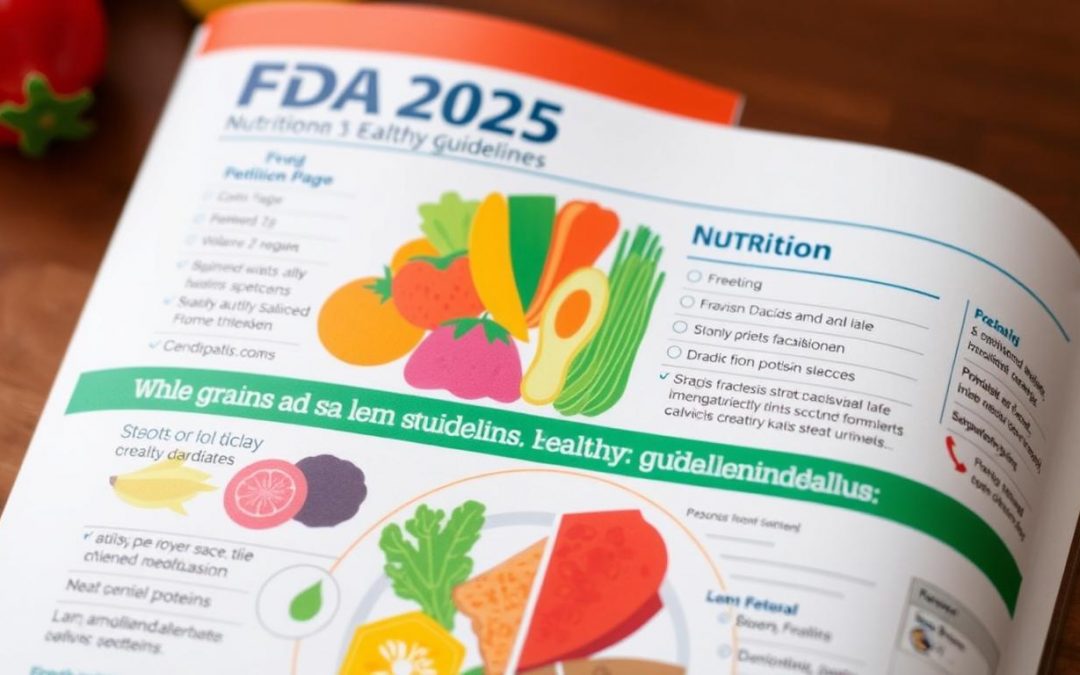The FDA updated the “healthy” claim on December 19, 2024. This change helps consumers find foods that are good for a healthy diet1. It’s part of the FDA’s effort to make food healthier and reduce chronic diseases.
The new guidelines aim to make it easier for people to choose better foods. They follow the latest nutrition science and federal dietary advice. This includes the FDA’s nutritional guidelines and food labeling rules.
Healthy labels are key in fighting diet-related diseases. These diseases are the top causes of death and disability in the U.S1. The “healthy” claim now focuses on foods like fruits, vegetables, and whole grains. These can lower the risk of heart disease, diabetes, some cancers, and obesity1.
The FDA’s new guidelines are important for health equity. They help reduce diet-related chronic diseases.
Table of Contents
Key Takeaways
- The FDA announced a final rule to update the “healthy” claim on December 19, 20241.
- The updated “healthy” claim aims to help consumers identify foods that are foundational for a healthy diet1.
- Healthy eating patterns can reduce the risk of cardiovascular disease, type 2 diabetes, certain types of cancers, and obesity1.
- The FDA healthy label guidelines 2025 are designed to provide a quick signal on food package labels to help consumers identify healthier food choices.
- The FDA nutritional guidelines and FDA food labeling regulations are essential in promoting health equity and reducing diet-related chronic diseases.
- The updated criteria align with current nutrition science, the Dietary Guidelines for Americans, and the amended Nutrition Facts label that requires declaration of added sugars1.
Introduction to the FDA Healthy Label Guidelines
The FDA’s health claims and labeling rules help us choose better food. These rules have changed a lot to guide us to healthier options. Learning about the FDA Healthy Label Guidelines is key to understanding healthy labels and what’s coming in 2025.
The “healthy” claim now focuses on nutrients to limit and foods that support a balanced diet2. The FDA also introduced food groups and food group equivalents (FGEs) for the “healthy” label2. This change makes it easier for us to spot healthier foods on labels.
Overview of the Guidelines
The FDA Healthy Label Guidelines explain the new “healthy” claim and its importance3. They aim to help us pick healthier foods by making labels clearer. The FDA got over 400 comments on the proposed rule2, showing how important this update is.
Importance of Healthy Labels
Healthy labels are key for making smart food choices. The FDA’s health claims and labeling rules ensure food products meet standards. Knowing these laws helps us find products that fit our dietary needs.
Anticipated Changes for 2025
New rules for 2025 include stricter “healthy” labeling based on food types2. Manufacturers must keep records to prove their products meet these standards2. These updates aim to give us more accurate info on the foods we buy.
Key Components of the Healthy Label
The FDA has updated its “healthy” rule. Now, it focuses on nutrient density and dietary patterns, not just single nutrients4. This change is key for following FDA labeling rules. It makes sure foods meet criteria for healthy groups and limits on added sugars, saturated fats, and sodium.
Manufacturers must follow these new rules to meet FDA standards. They focus on whole foods like veggies, fruits, and whole grains.
Foods labeled as healthy must now meet certain criteria5. They need to have a good amount of nutrients from food groups like fruits, veggies, grains, proteins, and dairy. Foods like veggies, fruits, whole grains, beans, peas, seafood, and nuts automatically qualify.
The FDA also introduced food groups and food group equivalents (FGEs) in the “healthy” definition. This helps consumers make better food choices.
Some key parts of the Healthy Label include:
- Nutritional information requirements
- Ingredient transparency
- Allergen warnings
These parts are vital for FDA labeling compliance. They help consumers eat healthily. By following these guidelines, manufacturers can make sure their products meet FDA standards and follow the new rules6.
New Front-of-Package Labeling
The FDA has introduced a new labeling system for food products. It makes it easier for people to understand what’s in their food7. This change is part of the FDA’s 2025 healthy label guidelines. It helps people make better food choices.
The labels will be simple and clear, making it easier to compare different foods8. This means people can see the nutritional differences more easily. The new labels will start on February 25, 2028. Businesses with over $10 million in sales have three years to adapt, while smaller ones have four9.
Some key features of the new labels include:
- A simple and concise design
- Easy-to-understand nutritional information
- Consistent labeling across different products
This new labeling system is a big step towards better food information. It’s a key part of the FDA’s efforts to encourage healthy eating and fight diet-related diseases7.
Changes in Serving Size Definitions
The FDA has updated serving size definitions to match what people usually eat at once10. This change helps consumers understand the nutritional content of food better. It’s key for making smart diet choices and FDA health claims. Food makers must update labels to meet FDA approved labeling requirements and FDA food labeling laws.
New serving sizes will make labels more accurate. For example, ice cream’s serving size now is 2/3 cup, up from ½ cup. Soda’s serving size has also grown, from 8 ounces to 12 ounces10. These updates help people know what they’re eating and choose healthier options.
Snacks, drinks, and meals have seen serving size changes. Labels now use bold for “Calories,” “servings per container,” and “Serving size”10. The FDA notes that some sizes reflect real eating habits, which is vital for FDA health claims and FDA approved labeling requirements.

The FDA is working to make food labels clearer and more accurate. This is important for those who want to make healthy diet choices and understand FDA health claims. By updating serving sizes and label formats, the FDA aims to help consumers make better choices. This is essential for a healthy diet and following FDA food labeling laws11.
Nutrient Criteria for Health Claims
The FDA has set rules for health claims on food labels. These rules are based on the latest in nutrition science and Federal dietary advice12. To get the “healthy” label, foods must have enough from key groups like fruits, veggies, or whole grains13.
There are limits for added sugars, saturated fats, and sodium on food labels12. These limits depend on how much of the food you eat. For example, foods must meet certain nutrient levels to get the “healthy” label13. This applies differently based on the food’s size.
It’s important to know what “high” and “low” nutrients mean. This helps you make better food choices. By following FDA rules, you can be sure the foods you pick are nutritious12.
Understanding “High” vs. “Low” Nutrients
The FDA sets limits for added sugars, saturated fats, and sodium. These are considered “high” nutrients12. Foods that go over these limits might not get the “healthy” label. But, foods low in these and rich in vitamins and minerals might qualify13.
Validating Nutritional Claims
Food makers must check their claims to make sure they’re true12. They need to keep records of their products’ nutrition and follow FDA rules13. This way, you can be sure the foods you choose are healthy.
| Nutrient | Limit |
|---|---|
| Added Sugars | Less than 10% of the Daily Value (DV) per serving |
| Saturated Fat | Less than 5% of the DV per serving |
| Sodium | Less than 10% of the DV per serving |
Impact on Food Marketing Strategies
The new “healthy” claim will change how food brands market their products. Brands must now follow the FDA’s updated guidelines for the “healthy” label. This includes limits on saturated fat, sodium, and added sugars14. The goal is to help consumers make better food choices, so brands must be clear and honest on their labels14.
Manufacturers with over $10 million in sales must follow the new rules in three years15. Those with less will have four years15. This will likely cause big changes in the industry. Brands will need to change their products to avoid warning labels15.
Brands should consider the following:
- Check and update product recipes to fit the new “healthy” claim standards
- Make sure labels are accurate and clear to follow FDA rules
- Focus on teaching consumers about their food choices
By following the new FDA guidelines and focusing on educating consumers, brands can succeed in the changing food market14. The FDA’s work to fight diet-related diseases will help everyone in the long run14.
| Category | Current Status | Updated Guidelines |
|---|---|---|
| Nutritional Information | Voluntary sodium reduction targets | Mandatory labeling requirements |
| Label Claims | Self-regulated | Standardized criteria for “healthy” claim |
Role of Artificial Intelligence in Labeling
The FDA is looking into using artificial intelligence (AI) for better labeling. This could make labeling more precise and help keep food safe. It’s all about following FDA health claims and labeling rules16.
AI could play a big role in making sure labels are right. It could also help the FDA make better decisions. This includes making sure food labels follow the law17.
AI can make sure food labels are correct and follow new “healthy” claim rules18. It can also watch for food safety issues early on. This keeps everyone safe and healthy. For more on choosing healthy foods, check out cooking tips and reviews.
AI and Food Safety Monitoring
AI helps spot food safety problems early. This makes sure food meets FDA standards16. It looks at food data to find patterns that might show a safety risk. This keeps us safe and healthy17.
Enhancements in Labeling Precision
AI makes labeling more precise. It helps food makers ensure labels are correct and follow the law18. By checking food ingredients and nutrition, AI finds labeling mistakes. This gives us accurate info about our food, which is key for health and safety16.
Addressing Public Health Concerns
The FDA is working hard to tackle issues like obesity and chronic diseases. They’ve updated the “healthy” claim19 to help. This change is part of their effort to make it easier for people to choose healthier foods. The new claim follows the dietary guidelines, focusing on eating well and cutting down on bad fats, salt, and sugars20.
The FDA wants to make it simple for people to pick healthy foods. They’re introducing new labels on the front of packages19. These labels will show how much saturated fat, sodium, and added sugars are in each product. This is all about encouraging a diet rich in nutrients and lowering disease risks21.
Here are some important points about FDA labeling:
* The “healthy” claim now focuses on five food groups from the dietary guidelines20
* Foods labeled “healthy” must meet certain criteria, like not too much sugar, salt, or bad fats20
* Companies need to keep records for two years to prove their product meets the “healthy” standards20
By keeping up with FDA labeling changes, people can make better food choices. This helps lower the risk of chronic diseases21. The FDA’s work on the “healthy” claim and new labels shows their commitment to public health and healthy eating19.
| Food Group | Recommended Daily Intake |
|---|---|
| Vegetables | 2.5 cups |
| Fruits | 2 cups |
| Grains | 6 ounces |
| Fat-free or low-fat dairy | 3 cups |
| Proteins | 5.5 ounces |

Labeling for Special Diets
Thinking about the FDA’s new label rules for 2025? These changes might affect your food choices, if you have a special diet. The FDA wants to make food labels clearer. This helps you make better choices. For example, labels now show if food is gluten-free or vegan, helping those with dietary needs22.
The new rules also cover allergies like tree nuts and soy. Food makers must label their products correctly. You can learn more on the FDA website. This way, you can eat healthier and lower your risk of diseases like heart disease and type 2 diabetes23.
Some important parts of the new rules include:
- Clearer info on gluten-free and vegan foods
- Right labeling of allergens like tree nuts and soy
- Nutritional info that’s easy to understand, like fat, sugar, and sodium
These updates aim to help you choose better for your health. By following the FDA’s guidelines, you can improve your health and well-being24.
Challenges and Critiques of the New Guidelines
The new “healthy” claim has met with resistance from the food industry and consumers. The industry worries about the cost and complexity of these changes25. Consumers are also skeptical, questioning the claim’s accuracy and effectiveness26.
Some major concerns include:
- Concerns about the cost and complexity of implementing the changes25
- Skepticism about the accuracy and effectiveness of the new labeling system26
- Questions about the impact of the new guidelines on the food industry and consumers25
It’s important to grasp the FDA health claims and FDA approved labeling requirements. The FDA food labeling laws aim to safeguard consumers. They ensure food products are labeled accurately and consistently26.
Conclusion: What to Expect in 2025
The FDA’s new “healthy” labeling rules will start in 202527. This means big changes for how food is labeled and sold28. The goal is to make it clearer and more accurate, helping people make better choices.
The FDA will keep shaping the food labeling world28. We can look forward to more updates on the “healthy” claim and possibly other labeling areas29. Their work is to help health and fight diet-related diseases.
Brands will have to teach people about their products and their benefits28. With closer watch on what they say, companies must be open and scientific to keep trust28. Working together, we can make food choices better and healthier for everyone.
FAQ
What are the FDA’s 2025 Healthy Label Guidelines?
What are the key components of the Healthy Label?
How will the new front-of-package labeling system benefit consumers?
How will the changes in serving size definitions impact label accuracy?
What are the nutrient criteria for health claims?
How will the updated “healthy” claim impact food marketing strategies?
How is the FDA exploring the use of artificial intelligence (AI) in labeling?
How do the updated “healthy” claim guidelines address public health concerns?
How have the updated labeling requirements for special diets been addressed?
What challenges and critiques have the updated “healthy” claim faced?
Source Links
- FDA Finalizes Updated “Healthy” Nutrient Content Claim – https://www.fda.gov/food/hfp-constituent-updates/fda-finalizes-updated-healthy-nutrient-content-claim
- FDA Finalizes a New Definition of ‘Healthy’ for Food Labeling | Insights | Greenberg Traurig LLP – https://www.gtlaw.com/en/insights/2025/1/fda-finalizes-a-new-definition-of-healthy-for-food-labeling
- Food Labeling Guide – https://www.fda.gov/regulatory-information/search-fda-guidance-documents/guidance-industry-food-labeling-guide
- FDA’s New Year, New Rules: Labeling for Healthier Choices | Insights | Holland & Knight – https://www.hklaw.com/en/insights/publications/2025/01/fdas-new-year-new-rules-labeling-for-healthier-choices
- The FDA’s “Healthy” Labeling Rules – Is Your Brand Ready for the New Standard? – https://ktslaw.com/en/insights/alert/2024/12/the fdas healthy labeling rules
- FDA Updates “Healthy” Label – https://www.aafp.org/pubs/afp/afp-community-blog/entry/fda-updates-healthy-label.html
- Front-of-Package Nutrition Labeling – https://www.fda.gov/food/nutrition-food-labeling-and-critical-foods/front-package-nutrition-labeling
- FDA Proposes Requiring At-a-Glance Nutrition Information on the Front of Packaged Foods – https://www.fda.gov/news-events/press-announcements/fda-proposes-requiring-glance-nutrition-information-front-packaged-foods
- FDA Proposes Front-of-Package Nutrition Label for Most Packaged Foods – https://www.pharmacytimes.com/view/fda-proposes-front-of-package-nutrition-label-for-most-packaged-foods
- Changes to the Nutrition Facts Label – https://www.fda.gov/food/nutrition-food-labeling-and-critical-foods/changes-nutrition-facts-label
- FDA’s Proposed Front-of-Package Nutrition Label Rule Reinforces Government Focus on Nutrition | Advisories | Arnold & Porter – https://www.arnoldporter.com/en/perspectives/advisories/2025/01/fda-proposed-front-of-package-nutrition-label-rule
- Webinar on the Updated “Healthy” Claim – https://www.fda.gov/food/workshops-meetings-webinars-food-and-dietary-supplements/webinar-updated-healthy-claim-02202025
- Food Labeling: Nutrient Content Claims; Definition of Term “Healthy” – https://www.federalregister.gov/documents/2024/12/27/2024-29957/food-labeling-nutrient-content-claims-definition-of-term-healthy
- FDA’s Nutrition Initiatives – https://www.fda.gov/food/nutrition-food-labeling-and-critical-foods/fdas-nutrition-initiatives
- How the FDA’s new nutrition labels could prod the food industry to get healthier – https://www.statnews.com/2025/01/15/nutrition-facts-label-fda-front-of-package-backed-by-science-opposed-by-industry/
- Considerations for the Use of Artificial Intelligence To Support Regulatory Decision-Making for Drug and Biological Products – https://www.fda.gov/media/184830/download
- FDA Releases Highly Anticipated Draft Guidance Documents on Artificial Intelligence Regarding Devices, Drugs, and Biological Products – https://www.cov.com/news-and-insights/insights/2025/01/fda-releases-highly-anticipated-draft-guidance-documents-on-artificial-intelligence-and-devices-drugs-and-biological-products
- FDA Issues Draft Guidance on AI-Enabled Medical Devices – https://www.orrick.com/en/Insights/2025/01/FDA-Issues-Draft-Guidance-on-AI-Enabled-Medical-Devices
- FDA Issues Proposed Rule on Front-of-Package Nutrition Labeling – https://www.fda.gov/food/hfp-constituent-updates/fda-issues-proposed-rule-front-package-nutrition-labeling
- FDA’s Fresh Take on Use of “Healthy” in Food Labeling – https://natlawreview.com/article/fdas-fresh-take-use-healthy-food-labeling
- 2025 Food and Supplements Outlook: FDA Human Foods Program’s Last Acts Before the New Administration – https://www.sidley.com/en/insights/newsupdates/2025/01/2025-food-and-supplements-outlook
- The FDA calls for at-a-glance nutrition labels on the front of packaged foods – https://www.npr.org/sections/shots-health-news/2025/01/14/nx-s1-5259691/fda-nutrition-labels-packaged-food
- FDA Cracks Down: New Rules for ‘Healthy’ Food Labels – https://www.medboundtimes.com/diet-and-nutrition/fda-cracks-down-new-rules-for-healthy-food-labels
- FDA issues updated final rule for “healthy” labeling | DLA Piper – https://www.dlapiper.com/en-us/insights/publications/2024/12/fda-issues-updated-final-rule-for-healthy-labeling
- FDA Issues Long-Awaited “Healthy” Rule – https://www.cov.com/en/news-and-insights/insights/2024/12/fda-issues-long-awaited-healthy-rule
- For the New Year, the FDA Is Changing What Foods Can Be Called ‘Healthy’ – https://www.scientificamerican.com/article/the-fda-is-changing-what-foods-can-be-called-healthy/
- FDA Issues Updated Final Rule for “Healthy” Labeling | JD Supra – https://www.jdsupra.com/legalnews/fda-issues-updated-final-rule-for-7122346/
- FDA Finalizes Guidance on Communication of Scientific Information on Unapproved Uses and Releases Updated First Amendment Analysis | Insights | Ropes & Gray LLP – https://www.ropesgray.com/en/insights/alerts/2025/01/fda-finalizes-guidance-on-communication-of-scientific-information
- Food Labeling: Nutrient Content Claims; Definition of Term “Healthy” – https://www.federalregister.gov/documents/2022/09/29/2022-20975/food-labeling-nutrient-content-claims-definition-of-term-healthy

